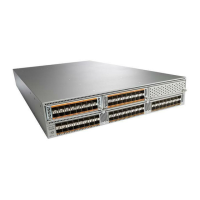Send feedback to nx5000-docfeedback@cisco.com
1-3
Cisco Nexus 5000 Series Switch CLI Software Configuration Guide
OL-16597-01
Chapter 1 Configuring Fibre Channel Interfaces
Information About Fibre Channel Interfaces
Figure 1-1 Switch Port Modes
Note Interfaces are automatically assigned VSAN 1 by default. See Chapter 1, “Configuring and Managing
VSANs.”
Each interface has an associated administrative configuration and an operational status:
• The administrative configuration does not change unless you modify it. This configuration has
various attributes that you can configure in administrative mode.
• The operational status represents the current status of a specified attribute such as the interface
speed. This status cannot be changed and is read-only. Some values may not be valid when the
interface is down (for example, the operational speed).
The following sections provide a brief description of each interface mode:
• E Port, page 1-3
• F Port, page 1-4
• NP Port, page 1-4
• TE Port, page 1-4
• SD Port, page 1-4
• Auto Mode, page 1-4
E Port
In expansion port (E port) mode, an interface functions as a fabric expansion port. This port may be
connected to another E port to create an Inter-Switch Link (ISL) between two switches. E ports carry
frames between switches for configuration and fabric management. They serve as a conduit between
switches for frames destined to remote N ports. E ports support class 3 and class F service.
An E port connected to another switch may also be configured to form a SAN port channel (see
Chapter 1, “Configuring SAN Port Channels”).
N port
Host
F port
E port E port
F port
ISL lin k
N port
187233

